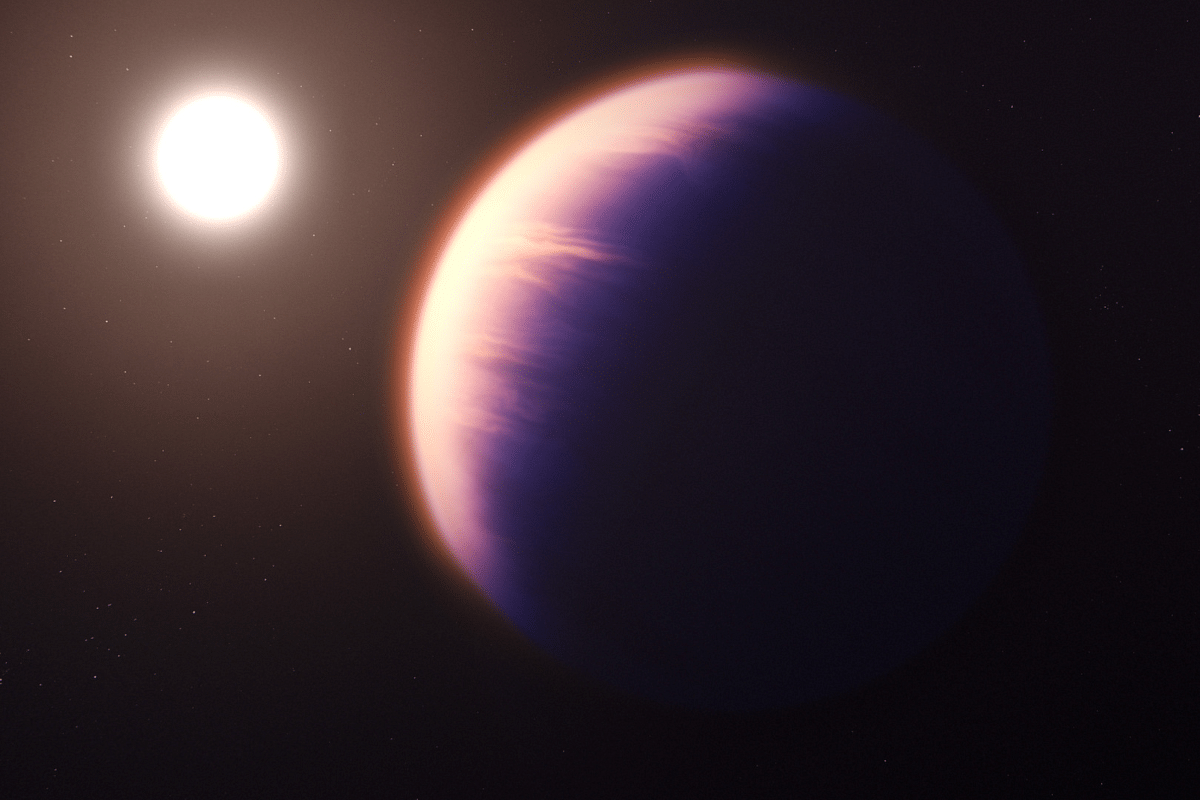Science
James Webb Space Telescope's First Exoplanet Find — Clear Evidence Of Carbon Dioxide Around Planet Far Away
- The James Webb Space Telescope has captured the first clear evidence for carbon dioxide in a planetary atmosphere outside our solar system.

This illustration shows what exoplanet WASP-39 b could look like, based on current understanding of the planet. (ARTWORK: NASA, ESA, CSA, Joseph Olmsted (STScI))
For the first time ever, there’s clear evidence of carbon dioxide in the atmosphere of an exoplanet, which is any planet outside our solar system.
This has implications for our knowledge of the birth and evolution of planets in the future.
No prizes for guessing who sniffed out the gas, though — it was the James Webb Space Telescope, the one behind a lot of the exciting models and discoveries of late, with a promise as vast as the universe it’s scoping out.
This marks Webb's first official scientific observation of an exoplanet.
The exoplanet in question is the hot, bloated gas giant WASP-39 b. It was discovered in 2011, thanks to the commonly used transit method. (The fact of its being a transiting planet with an inflated atmosphere helped to arrive at the finding.)
Webb’s first observation of WASP-39 b occurred on 10 July. The telescope observed the star, WASP-39, for eight hours.
“This observation of a gas giant planet orbiting a Sun-like star 700 light-years away provides important insights into the composition and formation of the planet,” NASA said 25 August in a statement about the new finding, which is set to find a place in the journal Nature soon.
Scientists believe they will get to learn about the origin and evolution of the planet through such observations. Once Webb throws up this measurement for many different kinds of planets, a more general picture of how planets form may emerge.
“In the coming decade, JWST will make this measurement for a variety of planets, providing insight into the details of how planets form and the uniqueness of our own solar system,” Mike Line of Arizona State University, a member of the research team, said.
“JWST” is short for James Webb Space Telescope, which is operated by NASA, the European Space Agency, and the Canadian Space Agency.
WASP-39 b is a gas giant. A gas giant is a large planet mostly composed of helium and/or hydrogen. In our solar system, the gas giants are Jupiter and Saturn.
Compared to Jupiter, WASP-39 b is roughly one-fourth as massive (mass similar to Saturn’s), 1.3 times bigger (diameter), and vastly hotter at a searing 900 degrees Celsius. (Jupiter’s mean temperature is negative 110 degrees Celsius while Saturn’s is negative 140.)
Curiously, the “hot Saturn,” as WASP-39 b is called, goes around its star once every four Earth days, separated from its “parent” by only one-eighth the distance between the Sun and Mercury. That’s awfully close to the star!
Previously, using Hubble (optical) and Spitzer (infrared) space telescopes, clear evidence was found “for a large amount of water vapor” (three times as much water as Saturn does) around WASP-39 b.
Now that carbon dioxide has been detected in its atmosphere — thanks to Webb’s Near-Infrared Spectrograph (NIRSpec) — it opens up the possibility of carbon dioxide detection, among other key molecules, in the thinner atmospheres of smaller, cooler rocky planets in the vein of Earth, Venus, and Mars.
“Detecting such a clear signal of carbon dioxide on WASP-39 b bodes well for the detection of atmospheres on smaller, terrestrial-sized planets,” Natalie Batalha of the University of California at Santa Cruz, who leads the team, said in the NASA statement.
The carbon dioxide detection has been described by Laura Kreidberg, director of Germany’s Max Planck Institute for Astronomy and co-author of the paper describing the discovery, as “a major milestone for exoplanet atmosphere characterisation.”
The 3 to 5.5-micron range transmission spectrum, where clear evidence of carbon dioxide emerged, provides a window of opportunity to measure abundances of gases like water and methane around exoplanets.
“This is like the first chapter in an entirely new book we’ll be writing about exoplanets in the coming months,” said Jacob Bean, a University of Chicago astronomer who co-leads the team analysing Webb’s exoplanet results.
As for WASP-39 b, the picture presented by Webb’s NIRSpec is not all. The larger investigation includes observations of the planet using multiple Webb instruments.
This scientific investigation using the Webb space telescope is being made available quickly because of the “Director’s Discretionary Early Release Science Programs.”
Observations in six science areas, made during the first five months of Webb’s operations, are designated for early release. “Planets and Planet Formation” is one of them, and it covers the WASP-39 b finding.
Over 300 scientists from around the world are participating in the study.
Jayesh M Goyal of Odisha’s School of Earth and Planetary Sciences, National Institute of Science Education and Research, and Agnibha Banerjee of the Indian Institute of Technology, Indore, are part of Webb’s Transiting Exoplanet Community Early Release Science Team.
Support Swarajya's 50 Ground Reports Project & Sponsor A Story
Every general election Swarajya does a 50 ground reports project.
Aimed only at serious readers and those who appreciate the nuances of political undercurrents, the project provides a sense of India's electoral landscape. As you know, these reports are produced after considerable investment of travel, time and effort on the ground.
This time too we've kicked off the project in style and have covered over 30 constituencies already. If you're someone who appreciates such work and have enjoyed our coverage please consider sponsoring a ground report for just Rs 2999 to Rs 19,999 - it goes a long way in helping us produce more quality reportage.
You can also back this project by becoming a subscriber for as little as Rs 999 - so do click on this links and choose a plan that suits you and back us.
Click below to contribute.
Latest